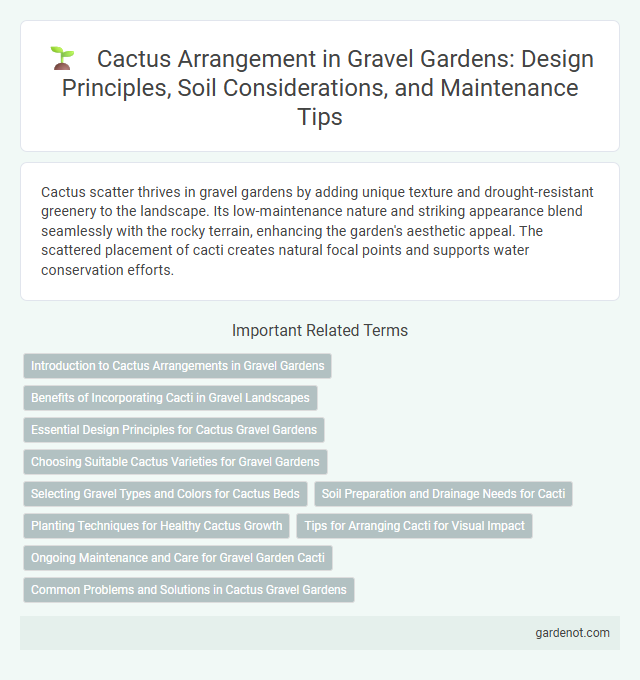Cactus scatter thrives in gravel gardens by adding unique texture and drought-resistant greenery to the landscape. Its low-maintenance nature and striking appearance blend seamlessly with the rocky terrain, enhancing the garden's aesthetic appeal. The scattered placement of cacti creates natural focal points and supports water conservation efforts.
Introduction to Cactus Arrangements in Gravel Gardens
Cactus scatter offers a visually striking and low-maintenance option for gravel gardens, thriving in well-drained, arid conditions. Arranging various succulent species with diverse shapes and sizes enhances both texture and color contrast, creating dynamic focal points. Ideal cactus varieties include Echinocactus, Opuntia, and Mammillaria, which adapt well to gravel mulch and minimal watering.
Benefits of Incorporating Cacti in Gravel Landscapes
Incorporating cacti into gravel landscapes enhances drought tolerance, reducing water consumption and maintenance efforts significantly. Their unique textures and shapes contribute to aesthetic diversity while thriving in poor soil conditions common to gravel gardens. Cacti also support local biodiversity by providing habitat and food sources for pollinators such as bees and hummingbirds.
Essential Design Principles for Cactus Gravel Gardens
Cactus scatter in gravel gardens thrives when incorporating essential design principles like well-draining soil, careful spacing to account for growth habits, and strategic placement to maximize sun exposure. Utilizing varied gravel textures and colors enhances cactus aesthetics while maintaining moisture control and preventing root rot. Integrating native stones and minimalist plant groupings creates a balanced, low-maintenance cactus gravel garden optimized for sustainability and visual appeal.
Choosing Suitable Cactus Varieties for Gravel Gardens
Selecting suitable cactus varieties for gravel gardens involves prioritizing drought-tolerant species such as Opuntia, Echinocactus, and Mammillaria, which thrive in well-draining, rocky soils. These cacti exhibit resilience to harsh sun exposure and minimal water, enhancing garden sustainability and reducing maintenance. Incorporating diverse shapes and sizes within these species ensures visual interest and ecological adaptation in gravel garden landscapes.
Selecting Gravel Types and Colors for Cactus Beds
Selecting gravel types for cactus beds requires prioritizing well-draining materials like decomposed granite, pea gravel, or lava rock to prevent water retention and root rot. Color choices should complement the natural hues of cacti, such as warm reds, burnt oranges, and sandy tans, enhancing the visual contrast and creating a desert-like aesthetic. Using varied gravel sizes, from fine dust to medium aggregates, improves soil aeration while adding texture and depth to the garden design.
Soil Preparation and Drainage Needs for Cacti
Cactus scatter thrives best in well-draining soil rich in sand, grit, or small gravel to prevent water retention that causes root rot. Soil preparation should include loosening the substrate and mixing organic matter sparingly to maintain a balance between nutrition and drainage. Adequate drainage is critical; incorporating raised beds or sloped terrain ensures excess water quickly drains away, mimicking the cactus's natural arid environment.
Planting Techniques for Healthy Cactus Growth
Planting techniques for healthy cactus growth in a gravel garden involve selecting well-draining soil mixtures combined with coarse gravel or sand to prevent water retention and root rot. Positioning cacti in full sunlight with adequate spacing promotes air circulation and reduces fungal infections. Regularly monitoring moisture levels and using shallow pots or raised beds enhances root aeration and supports vigorous growth in arid garden conditions.
Tips for Arranging Cacti for Visual Impact
Scatter cacti strategically by varying sizes, shapes, and heights to create dynamic visual interest in a gravel garden. Grouping spiny and smooth-textured species contrasts foliage, enhancing depth and texture. Place taller cactus varieties at the back and smaller ones upfront to maintain sightlines and emphasize architectural form.
Ongoing Maintenance and Care for Gravel Garden Cacti
Gravel garden cacti require minimal watering, typically only once every two to three weeks during the growing season to prevent root rot. Regularly remove debris and fallen leaves to maintain airflow and reduce pest risk in the sandy, well-draining substrate. Pruning damaged or overgrown stems supports healthy growth and enhances the aesthetic appeal of the cactus scatter arrangement.
Common Problems and Solutions in Cactus Gravel Gardens
Cactus gravel gardens often face common problems such as poor drainage, leading to root rot, and sunburn on sensitive species due to excessive direct sunlight. To prevent these issues, ensure soil is well-draining by incorporating sand or perlite, and provide partial shade during the hottest hours to protect vulnerable cacti. Regularly inspect for pests like mealybugs and aphids, applying insecticidal soap or neem oil promptly to maintain plant health.
Cactus scatter Infographic

 gardenot.com
gardenot.com